Find out what happens to each type of waste:
Refuse - what happens to black bin waste?
Once collected, refuse is sent to the Energy-from-Waste (EfW) facility at Rookery South, Stewartby.
EfW is a process that recovers energy from non-recyclable, non-hazardous household waste by using it as a fuel. Once delivered its placed in combustion chambers and burnt at high temperatures.
The heat generated heats up water in steel tubes around the chamber. This water is then converted to steam and delivered to a turbine that continuously generates electricity which is sent on to the National Grid (British power distribution system).
Any remaining residue is reprocessed to separate out metals for recycling whilst the remaining ash is recycled as a secondary aggregate.
Did you know?
In 2023, Central Bedfordshire disposed of approximately 50,000 tonnes of residual waste, which was then sent to energy recovery. This process generated enough electricity to power over 10,000 homes for a year.
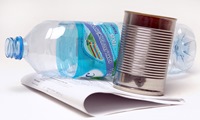
Recycling
Once collected from your kerbside or communal recycling bin, any recycling such as paper, cardboard, plastic packaging, cans, drink cartons and empty aerosols are transported to an MRF (Materials Recovery Facility), either in Elstow, Bedford or Grantham.
The MRF uses hand sorting and a range of technologies to sort the recyclable items into their different material types. The sorted materials are then baled ready for transportation to factories in the UK and abroad to be made into new recycled products which aren't necessarily the same product as before.

Household batteries
Once collected household batteries are sent to a plant near London where the various components are separated into three end products. These items are a zinc and manganese concentrate, steel, and paper, plastic and brass fractions. All of these products are put back into the market place for reuse in new products.
Plastic bottles
Recycled plastic bottles can be used to make clothing such as fleece jackets and hats or fibre filling for sleeping bags and duvets.
Paper and cardboard
Cardboard is usually made into new boxes and packaging, but can also be used as animal bedding!
Cans and aerosols
Steel cans and aerosols can be recycled into a variety of products including new cans, bicycle frames, pipes and train tracks. Both aluminium and steel can be recycled indefinitely without losing quality.
foodFood waste
Food waste collected from your brown caddy is taken to an anaerobic digestion facility.
Here, it is heated to a high temperature to remove bacteria and make it safe. It is placed in a sealed vessel where the mixture breaks down and the methane gases produced are collected. Electricity is generated from the methane gas collected, which is fed back to the national grid to supply local homes.
The fertiliser produced is used on farmers' land; therefore all your waste food will be recycled and used for good purposes.
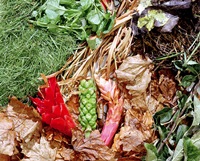
Garden waste
Once your garden waste has been collected, our refuse vehicles take the accumulated material to local composting sites in Haynes and Toddington where it is raked into windrows for both air and heat treatment.
This process gradually turns the material into a soil improver, which can then be used for agricultural purposes.
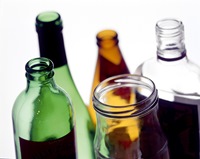
Glass
Your glass bottles and jars are taken to a sorting facility where they are cleaned and crushed into small pieces called cullet. X-ray and laser technology is used to separate the cullet into clear, brown and green glass.
The cullet is mixed with other materials, melted, cut and fired to make new products e.g. new glass bottles or to be used in building aggregates.
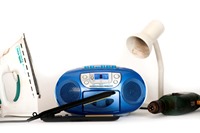
Small electrical items
Small electrical appliances include many products such as toasters, electrical toys, kettles, power tools and irons. This is the possibly the most complicated waste stream to recycle as they often contain many different material types which can be recovered: wood, metal, plastic and glass.
Firstly the items are manually treated so that the other materials are separated from the metals. Initial de-contamination may include removal of ink toners, cartridges, batteries and cables.
The products then travel through various mechanical processes to separate the ferrous metal, non-ferrous metal and any remaining plastic components for granulation. The granulated material may be used in the car or building industry.
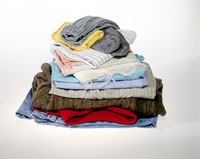
Textiles
Following collection the clothes and textiles are sent in bulk to a plant in Germany where the clothing and non clothing items are sorted to over 400 grades. These grades for clothes include being sorted by material and textile types; denims, cottons, leathers, synthetics. By types of clothes: trousers shirts, jackets, blouses. By target groups: men, women, children. By brand, fashion styles, colours and quality types and by technical, legal and cultural aspects.
Emerging nations are keen to accept these quality textiles originating from the UK, because in terms of both design and durability, they are often superior to newly made products from Far East countries.
Nothing is wasted in the recycling process. Tonnes of zips, buttons and rivets are extracted and recycled. Even the dust that is generated in the process is compacted into briquettes and used in the manufacture of paper and concrete. Even the plastic bags the clothes and shoes are collected in are forwarded on for reprocessing.
Any old textiles, even if they are damaged can still be recycled. They can be shredded and then used as industrial cloths or padding for chairs and car seats. Some textiles can be shredded into fibres and then turned into new items such as insulation.
Coffee pods
The coffee pods you recycle with Podback (through our kerbside collection scheme) are taken to specialist aluminium and plastics reprocessing plants in the UK. The coffee grounds are removed, and the plastic and aluminium are then transformed into new products, including beverage cans, plastic food trays and packaging crates. The coffee grounds are used to create renewable energy (biogas) and soil improver.